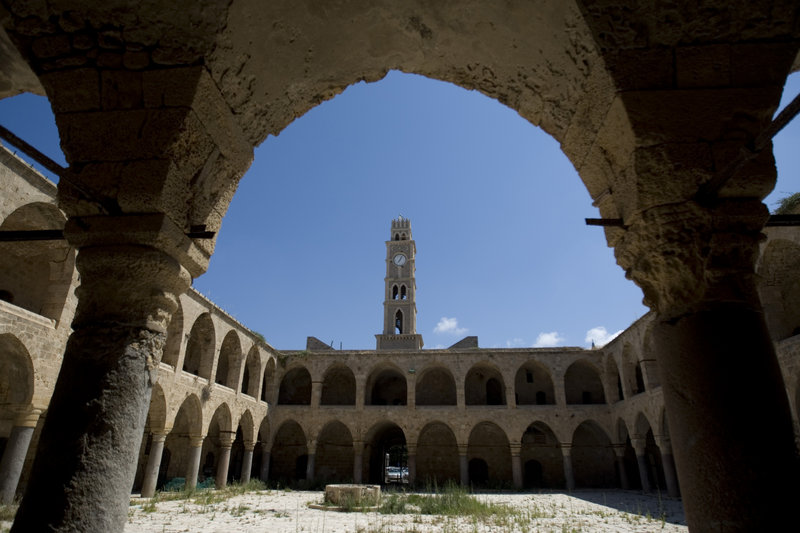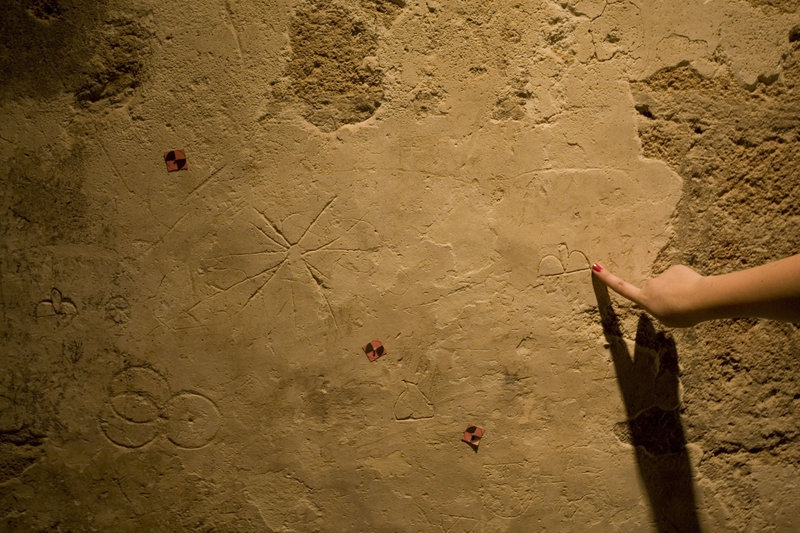ACRE, Israel – Off the track beaten by most Holy Land tourists lies one of the richest archaeological sites in a country full of them: the walled port of Acre, where the busy alleys of an Ottoman-era town cover a uniquely intact Crusader city now being rediscovered.
Preparing to open a new subterranean section to the public, workers cleaned stones this week in an arched passageway underground.
Etched in plaster on one wall was a coat of arms — graffiti left by a medieval traveler. Nearby was a main street of cobblestones and a row of shops that once sold clay figurines and ampules for holy water, popular souvenirs for pilgrims.
All were last used by residents in 1291, the year a Muslim army from Egypt defeated Acre’s Christian garrison and leveled its remains.
The existing city, built by the Ottoman Turks around 1750, effectively preserved this earlier town, which had been hidden for centuries under the rubble.
“It’s like Pompeii of Roman times — it’s a complete city,” said Eliezer Stern, the Israeli archaeologist in charge of Acre. He called the town “one of the most exciting sites in the world of archaeology.”
The newly excavated area, part of a Crusader neighborhood, is set to open later this year.
Today, old Acre is a picturesque enclave jutting into the Mediterranean, home to 5,000 Arab citizens of Israel who live in dense warrens of homes that are themselves historic artifacts. Most residents are poor.
On a recent afternoon, a smattering of tourists walked through the old market, while at a sleepy fishing dock one boat’s radio blared Katy Perry.
In 2001, Acre became Israel’s first UNESCO World Heritage site. But whether because of its out-of-the-way location in the country’s north or simply because it must compete with better-known sites like Jerusalem and the desert fortress of Masada, Acre has been overshadowed.
Jerusalem, for example, attracted an estimated 2.5 million foreign tourists last year, according to the Tourism Ministry. In contrast, during the same period, Acre’s historic sites had 444,000 paying visitors — Israeli and foreign — according to the Acre Municipality. Old Acre has just one hotel with a total of 16 rooms.
Acre has existed for at least 4,500 years, but reached the height of its importance with the Crusader conquest in 1104.
Under Christian rule, the city became an unruly trading hub home to combative orders of soldier-monks, European factions that distrusted each other and sometimes fought in the streets, competing merchants from cities like Genoa, Venice and Pisa, and small populations of Jews and Muslims, all sharing an enclosed area that at its height was barely the size of two football fields.
A French bishop, Jacques de Vitry, reached Acre after a perilous sea journey in 1216. He was appalled.
“When I entered this horrible city and found it full of countless disgraceful acts and evil deeds, I was very confused in my mind,” he wrote in a letter home.
Acre, he found, was “totally depraved.” Murders took place constantly, the town was “filled with prostitutes,” and residents — many of whom he believed to be outlaws who had fled their own lands — were “utterly devoted to pleasures of the flesh.”
Acre was “like a monster or a beast having nine heads, each fighting the other,” the bishop wrote.
Israeli excavations got under way in earnest in the 1990s, and some remnants of the city that de Vitry knew can already be visited. One is the fortress of the Hospitaller knights, with its pillared dining hall and storerooms, an orderly latrine and a dungeon whose stone walls have holes for attaching shackles.
Also open is an underground passage constructed by the knights of the rival Templar order, leading from their own fortress to the port. Some used it on the day Acre fell to escape to Europe-bound vessels as their city, and the two-century-old Crusader kingdom, collapsed around them.
Underwater digs in Acre’s harbor have revealed sunken fortifications and more than 20 lost ships. Workers are now shoring up one of Acre’s seawalls — which witnessed assaults by Napoleon, the Egyptian ruler Ibrahim Pasha, and a combined British, French and Austrian fleet — discovering, in the process, Napoleonic cannonballs and a Hellenistic pier more than two millennia old.
Acre, with newer neighborhoods, has grown to 56,000 people. It has experienced occasional ethnic tension, but the streets feel safe, and residents are welcoming. The past, residents seem to recognize, is their city’s primary resource.
“It’s a whole ancient city underground,” said Bassam Dabour, a storeowner in the Old City market. “It’s beautiful — why not continue working?”
Send questions/comments to the editors.



